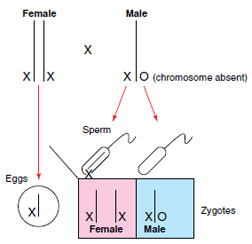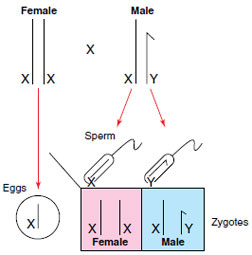Sex Determination
Sex Determination
Before the importance of chromosomes
in heredity was realized in the early
1900s, how gender was determined was
totally unknown. The first really scientific
clue to the determination of sex
came in 1902 when C. McClung
observed that bugs (Hemiptera) produced
two kinds of sperm in approximately
equal numbers. One kind contained
among its regular set of
chromosomes a so-called accessory
chromosome that was lacking in the
other kind of sperm. Since all the eggs
of these species had the same number
of haploid chromosomes, half the
sperm would have the same number of
chromosomes as the eggs, and half of
them would have one chromosome
less. When an egg was fertilized by a
spermatozoon carrying the accessory
(sex) chromosome, the resulting offspring
was a female; when fertilized by
the spermatozoon without an accessory
chromosome, the offspring was a male.
Therefore a distinction was made
between sex chromosomes, which
determine sex (and sex-linked traits);
and autosomes, the remaining chromosomes,
which do not influence sex.
The particular type of sex determination
just described is often called the XX-XO
type, which indicates that the females
have two X chromosomes and the
males only one X chromosome (the O
indicates absence of the chromosome).
The XX-XO method of sex determination
is depicted in Figure 5-3.
Speculation on how sex was determined in animals produced several incredible theories, for example,that the two testicles of the male contained different types of semen,one begetting males, the other females. It is not difficult to imagine the abuse and mutilation of domestic animals that occurred when attempts were made to alter the sex ratios of herds. Another conjecture asserted that sex of the offspring was determined by the more heavily sexed parent. An especially masculine father should produce sons, an effeminate father only daughters.Such mistaken ideas have lingered until recently.
Later, other types of sex determination
were discovered. In humans and
many other animals each sex contains
the same number of chromosomes;
however, the sex chromosomes (XX)
are alike in the female but unlike (XY)
in the male. Hence the human egg contains
22 autosomes + 1 X chromosome.
The sperm are of two kinds; half carry
22 autosomes + 1 X and half bear 22
autosomes + 1 Y. The Y chromosome
is much smaller than the X and carries
very little genetic information. At fertilization,
when the 2 X chromosomes
come together, the offspring are female;
when X and Y come together, the offspring
are male. The XX-XY kind of
determination is shown in Figure 5-4.
A third type of sex determination is found in birds, moths, butterflies, and some fish in which the male has 2 X (or sometimes called ZZ) chromosomes and the female an X and Y (or ZW). Finally, there are both invertebrates and vertebrates in which sex is determined by environmental or behavioral conditions rather than by sex chromosomes, or by genetic loci whose variation is not associated with visible difference in chromosomal structure.
In the case of X and Y chromosomes, the homologous chromosomes are unlike in size and shape. Therefore, they do not both carry the same genes. The genes of the X chromosome often do not have allelic counterparts on the diminutive Y chromosome. This fact is very important in sex-linked inheritance, which we shall discuss later.
We now know that not all animals with dioecious reproduction have their genders determined chromosomally. Several invertebrate examples are known. Many fishes and reptiles lack sex chromosomes altogether; in these organisms, gender is determined by nongenetic factors such as temperature or behavior. In crocodilians, many turtles, and some lizards the incubation temperature of the nest determines the sex ratio by some as yet unknown sex-determining mechanism. Alligator eggs, for example, incubated at low temperature become all females; those incubated at higher temperature become all males. Sex determination of many fishes depends on behavior. Most of these species are hermaphroditic, possessing both male and female gonads. Sensory stimuli from the animal’s social environment determine whether it will be male or female.
 |
| Figure 5-3 XX-XO sex determination. |
Speculation on how sex was determined in animals produced several incredible theories, for example,that the two testicles of the male contained different types of semen,one begetting males, the other females. It is not difficult to imagine the abuse and mutilation of domestic animals that occurred when attempts were made to alter the sex ratios of herds. Another conjecture asserted that sex of the offspring was determined by the more heavily sexed parent. An especially masculine father should produce sons, an effeminate father only daughters.Such mistaken ideas have lingered until recently.
 |
| Figure 5-4 XX-XY sex determination. |
A third type of sex determination is found in birds, moths, butterflies, and some fish in which the male has 2 X (or sometimes called ZZ) chromosomes and the female an X and Y (or ZW). Finally, there are both invertebrates and vertebrates in which sex is determined by environmental or behavioral conditions rather than by sex chromosomes, or by genetic loci whose variation is not associated with visible difference in chromosomal structure.
In the case of X and Y chromosomes, the homologous chromosomes are unlike in size and shape. Therefore, they do not both carry the same genes. The genes of the X chromosome often do not have allelic counterparts on the diminutive Y chromosome. This fact is very important in sex-linked inheritance, which we shall discuss later.
We now know that not all animals with dioecious reproduction have their genders determined chromosomally. Several invertebrate examples are known. Many fishes and reptiles lack sex chromosomes altogether; in these organisms, gender is determined by nongenetic factors such as temperature or behavior. In crocodilians, many turtles, and some lizards the incubation temperature of the nest determines the sex ratio by some as yet unknown sex-determining mechanism. Alligator eggs, for example, incubated at low temperature become all females; those incubated at higher temperature become all males. Sex determination of many fishes depends on behavior. Most of these species are hermaphroditic, possessing both male and female gonads. Sensory stimuli from the animal’s social environment determine whether it will be male or female.




